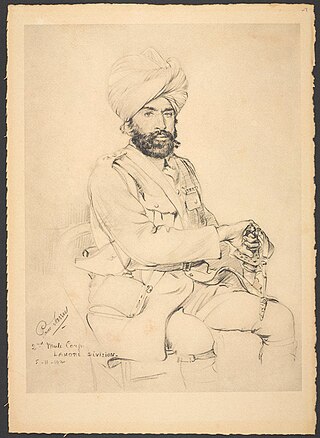
The 13th (Western) Division was one of the Kitchener's Army divisions in the First World War, raised from volunteers by Lord Kitchener. It fought at Gallipoli, in Mesopotamia and Persia.
The 10th Indian Division was an infantry division of the British Indian Army during World War I. It was formed in Egypt in December 1914 with three infantry brigades of Indian Expeditionary Force F. After taking part in the Actions on the Suez Canal, the division was dispersed as its brigades were posted away.

The Indian Army, also called the British Indian Army, was involved in World War I as part of the British Empire. Almost 1.5 million Indian troops served overseas, of whom 62,000 died and another 67,000 were wounded. In total at least 74,187 Indian soldiers died during the war.

The 7th (Meerut) Division was an infantry division of the Indian Army and before 1895, the Bengal Army, that saw active service during World War I.

The 3rd (Lahore) Division was an infantry division of the Indian Army and before 1895, the Bengal Army, first organised in 1852. It saw service during World War I as part of the Indian Corps in France before being moved to the Middle East where it fought against troops of the Ottoman Empire.
The 2nd Indian Cavalry Division was a division of the British Indian Army formed at the outbreak of World War I. It served on the Western Front, being renamed as 5th Cavalry Division on 26 November 1916. In March 1918, the 5th Cavalry Division was broken up. The British and Canadian units remained in France and the Indian elements were sent to Egypt to help constitute 2nd Mounted Division.
The 11th Indian Cavalry Brigade was a cavalry brigade of the British Indian Army that saw active service in the Indian Army during the First World War. It took part in the Mesopotamian campaign and was broken up soon after the end of the war.
The Meerut Cavalry Brigade was a cavalry brigade of the British Indian Army formed in 1904 as a result of the Kitchener Reforms. It was mobilized as 7th (Meerut) Cavalry Brigade at the outbreak of the First World War and departed for the Western Front where it served as part of the 2nd Indian Cavalry Division.
The 6th (Poona) Division was a division of the British Indian Army. It was formed in 1903, following the Kitchener reforms of the Indian Army.
Indian Army during World War I order of battle
The 34th Indian Brigade was an infantry brigade of the British Indian Army that saw active service in the Mesopotamian campaign in the Indian Army during the First World War. It was reformed for the Second World War as the 34th Indian States Forces Infantry Brigade.
The 11th Gurkha Rifles was a Gurkha regiment of the British Indian Army. It was formed in Mesopotamia and Palestine in May 1918, saw active service in the First World War and the Third Anglo-Afghan War, and was disbanded in April 1922.

The 6th Indian Cavalry Brigade was a cavalry brigade of the British Indian Army that saw active service in the Indian Army during the First World War. It took part in the Mesopotamian campaign and was broken up soon after the end of the war.
The Garhwal Brigade was an infantry brigade of the British Indian Army formed in 1902 as a result of the Kitchener Reforms. It was mobilized as 20th (Garhwal) Brigade at the outbreak of the First World War as part of the 7th (Meerut) Division and departed for France. It served on the Western Front until November 1915. It then moved to Egypt where it joined the 10th Indian Division, by now designated as 20th Indian Brigade. It left the division in March 1916 and thereafter served as an independent brigade in the Sinai and Palestine Campaign. It was broken up in 1920.
The 30th Indian Brigade was an infantry brigade of the British Indian Army that saw active service with the Indian Army during the First World War. It initially saw active service in Egypt in 1915, before transferring to Mesopotamia. It took part in a number of battles and actions before being besieged at Kut and going into Turkish captivity in April 1916.
The 12th Indian Brigade was an infantry brigade of the British Indian Army that saw active service in the First World War. It served in the Mesopotamian Campaign on the Euphrates Front throughout its existence.
The 35th Indian Brigade was an infantry brigade of the British Indian Army that saw active service with the Indian Army during the First World War. It took part in the Mesopotamian campaign and was disbanded shortly after the end of the war. It was not reformed for the Second World War.

The 37th Indian Brigade was an infantry brigade of the British Indian Army that saw active service with the Indian Army during the First World War. It took part in the Mesopotamian campaign and was disbanded shortly after the end of the war.
The 36th Indian Brigade was an infantry brigade of the British Indian Army that saw active service with the Indian Army during the First World War. It took part in the Mesopotamian campaign and later formed part of the North Persia Force. It remained with the Force until withdrawn in June 1921.
The 151st Sikh Infantry – also designated 151st Punjabi Rifles, see nomenclature (below) – was an infantry regiment of the British Indian Army. It was formed in Mesopotamia and Palestine in May 1918, saw active service in the First World War and the Third Anglo-Afghan War, and was disbanded in May 1921.





